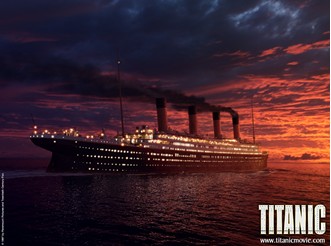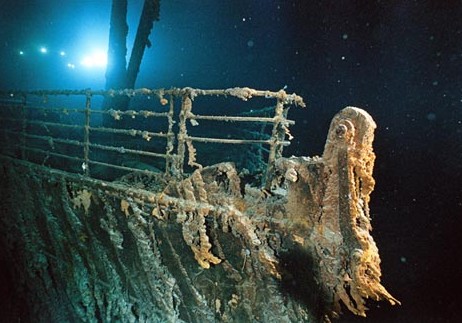历史上曾经出现了多次海难事件,最广为人知的无疑是泰坦尼克号海难。这艘号称“永不沉没”的远洋客轮在1912年的处女航行中撞上了冰山,在短短几小时内沉没于北大西洋,造成1500人罹难。其残骸于1985年被发现。二十几年过去了,这座海底坟墓如今有什么变化呢?让我们跟随当年发现残骸的科学家们重访这艘富有传奇色彩的巨轮。
听力小提示:本文生词较多,只适合作为泛听材料使用。建议先听一遍声音,记下听到的信息点,然后阅读文字,对照一下自己掌握的内容有没有错漏。
 Everyone’s heard dramatic tales about the wreck[失事] of the Titanic, but did you know that this storied[传说上有名的], luxury liner[邮轮] may be on the verge of[濒临于] vanishing[消失] once again? This time it’s not due to an unyielding[坚硬的] iceberg. Instead, a bizarre[奇异的] rust-eating bacteria[细菌] may be to blame.
Everyone’s heard dramatic tales about the wreck[失事] of the Titanic, but did you know that this storied[传说上有名的], luxury liner[邮轮] may be on the verge of[濒临于] vanishing[消失] once again? This time it’s not due to an unyielding[坚硬的] iceberg. Instead, a bizarre[奇异的] rust-eating bacteria[细菌] may be to blame.
The scientist Robert Ballard found the famous wreck of the Titanic in 1985. Recently he went back with a team of researchers to see how the ship’s faring[进展] in its deep-sea grave. They discovered the wreckage is decaying[腐烂] a lot faster than expected. Many of the Titanic’s grand structures have collapsed. Masts[桅杆] and railings[栏杆] have fallen, and some of the ship’s nine decks[甲板] have caved in[下陷]. One of the main culprits[罪犯]? A strange iron-eating bacteria that’s feeding on the ship’s metal skeleton. They produce rust-colored blisters[水泡] that spread out across the promenade deck[散步甲板], orange rivulets[溪流] that flow from the hull into vast, fan-shaped outflows[流出物] and eerie[怪诞的,可怕的]-looking rusticles注 – icicle[冰柱]-shaped deposits[沉淀物] of iron and bacterial sludge[软泥] that now enshroud[掩盖] much of the wreck.
Researchers think the iron-eating bacteria includes at least one strain[一种] that’s never been seen before. They thrive[茁壮成长] in extreme environments where we thought no life could survive. Two and a half miles beneath the sea, there’s no light or oxygen. It’s freezing cold, and the water pressure reaches a bone-crushing 6,000 pounds per square inch. Yet these bacteria colonize[拓殖] and grow rapidly on the ship’s steel, devouring[吞吃] the iron inside, which is weakening the structure. Researchers are studying this process and examining photos taken when the wreck was discovered in 1985 to figure out how much longer the ship can survive.
More than 2,000 people were aboard the “unsinkable” ocean liner when it struck an iceberg and sank on April 15th, 1912. At least 1,500 died in the frigid[寒冷的] North Atlantic waters, but roughly 700 managed to survive.
Today, hungry microbes[微生物] aren’t the only cause of the Titanic’s deep-sea destruction. Several prized artifacts that Ballard and his team spotted in 1985 appeared to be missing when they returned. Some researchers believe that looters[掠夺者] and thrill[刺激]-seekers may be to blame. Licensed[得到许可的] salvagers[打捞人员] can take historic artifacts from the wreck site, but others may be taking them illegally. There’s tremendous[巨大的]debate about efforts to remove artifacts from the Titanic, but nature remains the ship’s greatest threat.
Estimates vary on how long it will take the strange iron-eating bacteria to finish their feast[盛宴], but most scientists agree that the massive ship is likely to be nothing more than a rust stain on the ocean floor by the end of the century.

每个人都听说过富有戏剧性的泰坦尼克号海难事件,但你是否知道这艘历史上有名的豪华邮轮可能再一次消失?这一次倒不是因为某座坚硬的冰山,而要归咎于一种吞噬铁锈的怪异细菌。
科学家罗伯特·巴拉德于1985年发现了著名的泰坦尼克号的残骸。最近他和一队研究人员再次造访这艘船,看看它在深海墓穴中有什么变化。他们发现其残骸的腐烂速度比预想中要快得多。泰坦尼克号的许多巨型结构都已经崩塌。船桅和栏杆均已倒下,而船上的九层甲板也有一部分已经塌陷。罪魁祸首是什么?一种噬铁的奇怪细菌,它们以船上的金属框架为食。他们制造出来的铁锈色水泡已经蔓延过散步甲板,从船体中流出的橙色溪流形成了巨大的扇形流体,并生成了怪诞可怕的“锈柱”——亦即覆盖了大部分船体残骸的冰柱状铁沉积物和菌泥。
研究人员认为,这些噬铁的细菌至少包括一种此前从未被发现的品种。它们在我们认为没有生命能够存活的极端环境中茁壮成长。在海面下两英里半(4千米)的地方,没有光或氧气存在。这里极其寒冷,水压达到了每平方英寸6000磅(每平方厘米421公斤),足以压碎骨头。然而这些细菌在船身的钢铁中开辟领地并快速生长,吞食其中的铁,不断削弱船的结构。研究人员正在研究这一过程。他们仔细检查1985年发现残骸时拍下的照片,以便计算出这艘船还能存在多久。
1912年4月15日,当它撞上一座冰山沉没时,这艘“永不沉没的”远洋客轮上搭载着两千多名乘客。至少有1500人在这片极度寒冷的北大西洋水域中丧命,大约700人逃出生天。
如今,饥饿的微生物并不是泰坦尼克号在深海中消亡的唯一原因。巴拉德及其研究小组重返旧地时发现,他们在1985年发现的很多珍贵手工艺品已经不知所踪。一些研究人员相信,这要归咎于强盗和寻求刺激的探险者。持有执照的打捞人员能够从残骸遗址取走历史文物,但其他人可能会非法盗取物品。人们对于将手工艺品从泰坦尼克号移走的尝试一直争论不休,但大自然依然是这艘船最大的威胁。
对于这种噬铁的奇怪细菌需要多长时间来完成它们的盛宴,预测结果各不相同。但大多数科学家都认同这一推测——到本世纪末,这艘巨轮有可能变成大洋底部的一块锈迹。
注:“rusticle”是外形类似于冰柱或钟乳石的一种锈,是铸铁在水下经氧化后的产物。该词是“rust”和“icicle”的合成词。罗伯特·巴拉德首次在泰坦尼克号残骸上观察到这种物质后创造了这个词。
